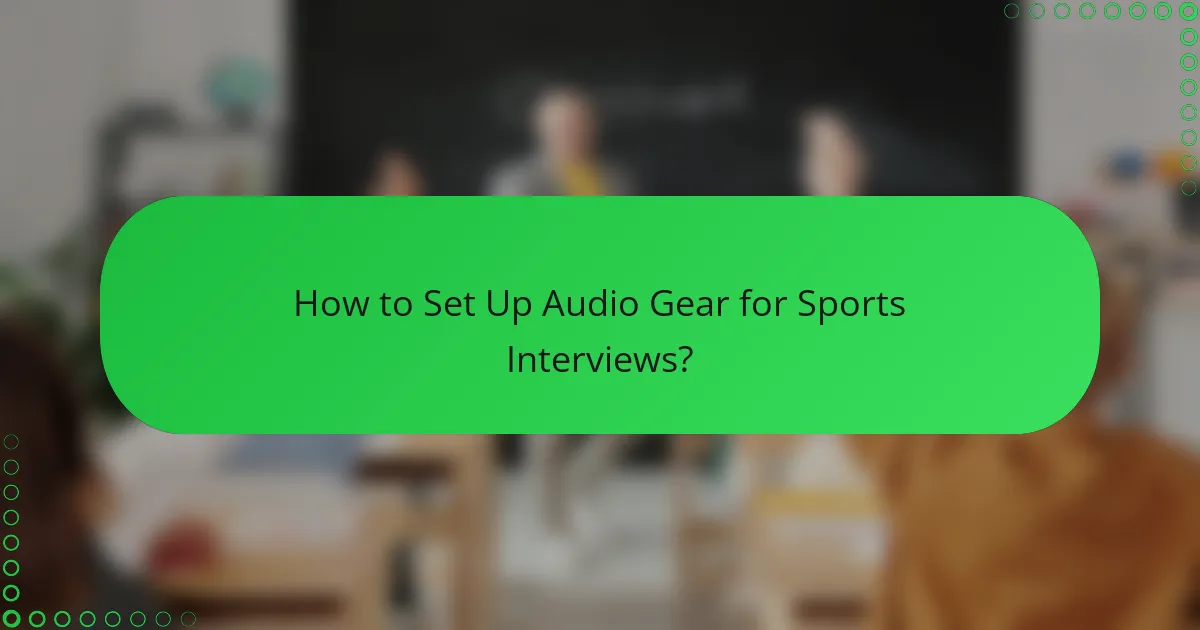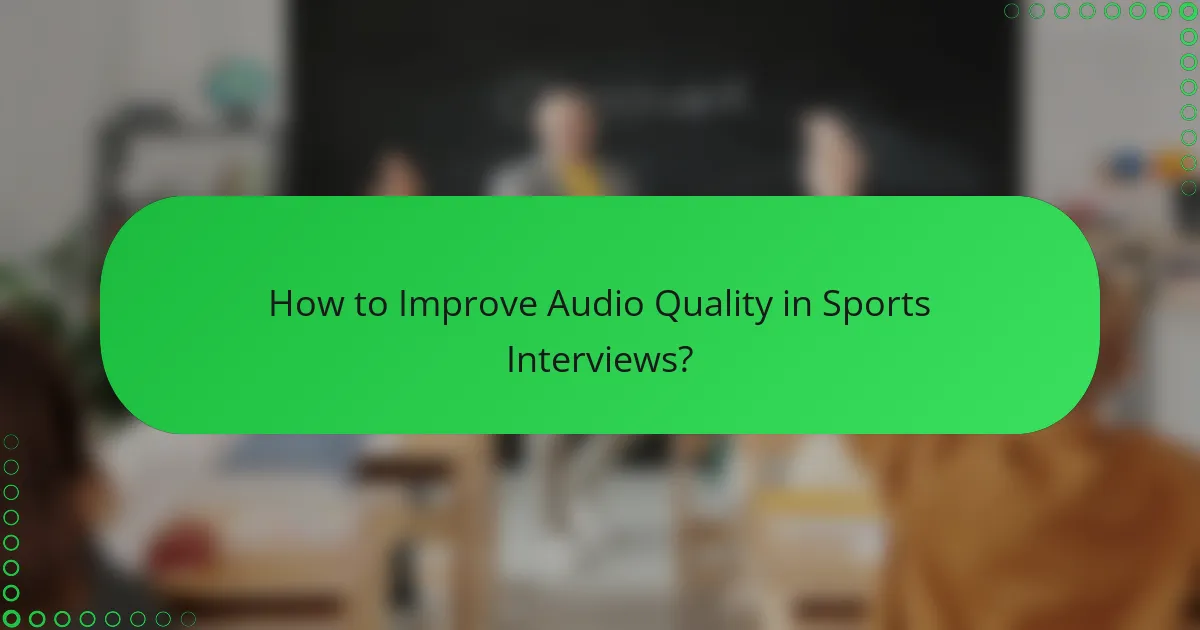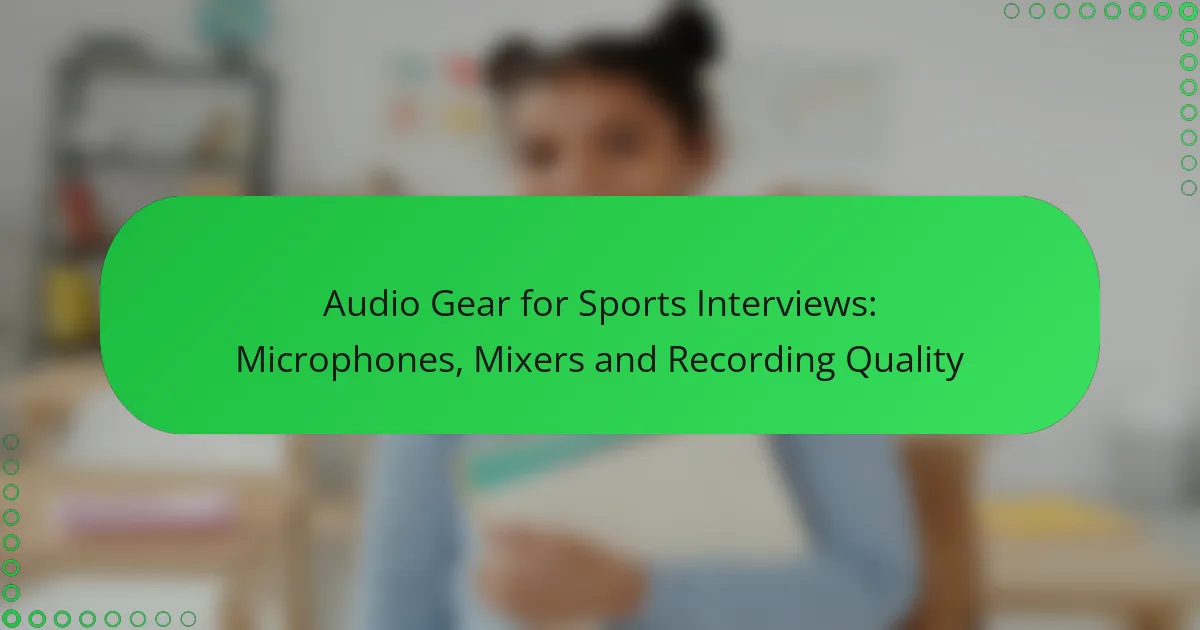When conducting sports interviews, selecting the right audio gear is crucial for capturing clear and engaging sound. High-quality microphones with directional pickup patterns and durable designs are essential, while portable mixers with multiple channels enhance audio control. Additionally, aiming for a recording quality of at least 24-bit/96 kHz ensures that every nuance of the conversation is preserved, creating a professional listening experience.

What Are the Best Microphones for Sports Interviews?
The best microphones for sports interviews are those that effectively capture clear audio in dynamic environments. Key features to consider include directional pickup patterns, durability, and compatibility with recording devices.
Shure SM7B
The Shure SM7B is a dynamic microphone renowned for its versatility and rich sound quality. Its cardioid pattern minimizes background noise, making it ideal for capturing interviews in bustling sports venues.
This microphone requires a good preamp due to its low output level, so pairing it with a quality mixer or audio interface is essential. It’s a popular choice among broadcasters and podcasters for its reliability and performance.
Rode NTG3
The Rode NTG3 is a shotgun microphone designed for professional audio applications, particularly in outdoor settings. Its supercardioid pattern effectively isolates the subject’s voice while rejecting off-axis noise, which is crucial during live sports interviews.
With a robust build and weather-resistant features, the NTG3 can withstand various environmental conditions. It’s often used with boom poles or handheld setups, providing flexibility in capturing audio from different angles.
Sennheiser MKE 600
The Sennheiser MKE 600 is another excellent shotgun microphone that excels in capturing clear audio in noisy environments. Its design focuses on voice clarity, making it suitable for interviews where background noise is prevalent.
This microphone offers a low-cut filter to reduce wind noise and handling sounds, enhancing the overall audio quality. It’s compatible with various recording devices, making it a versatile option for sports interviews.
Audio-Technica AT875R
The Audio-Technica AT875R is a compact shotgun microphone that provides high-quality audio in a lightweight design. Its short length makes it ideal for use in tight spaces, such as on-camera interviews during sports events.
This microphone features a narrow pickup pattern that effectively reduces ambient noise, ensuring the interviewee’s voice is the primary focus. It’s a budget-friendly option without compromising on sound quality, making it popular among aspiring sports journalists.

How to Choose the Right Mixer for Sports Interviews?
Choosing the right mixer for sports interviews involves considering factors like portability, number of channels, and built-in effects. A good mixer should facilitate clear audio capture while being easy to operate in dynamic environments.
Yamaha MG10XU
The Yamaha MG10XU is a versatile mixer ideal for sports interviews due to its compact size and high-quality preamps. It features 10 input channels, allowing for multiple microphones and devices to be connected simultaneously.
This mixer also includes built-in digital effects and USB connectivity, making it easy to record directly to a computer. Its robust construction ensures durability, which is essential for outdoor or on-the-go interviews.
Behringer Xenyx Q802USB
The Behringer Xenyx Q802USB is a budget-friendly option that offers solid performance for sports interviews. With 8 input channels and built-in compression, it helps maintain consistent audio levels, which is crucial in noisy environments.
This mixer also provides USB output for easy recording and playback, making it a practical choice for those on a tight budget. Its lightweight design enhances portability, allowing for easy transport to various interview locations.
Soundcraft Notepad-8FX
The Soundcraft Notepad-8FX combines professional-grade features with user-friendly operation, making it suitable for sports interviews. It offers 8 channels and high-quality effects, ensuring clear and engaging audio capture.
This mixer is particularly noted for its intuitive layout, which simplifies the mixing process during live interviews. Additionally, its compact design and built-in USB interface facilitate easy recording and playback, enhancing its practicality for field use.

What Recording Quality Is Needed for Sports Interviews?
For sports interviews, a recording quality of at least 24-bit/96 kHz is recommended to capture clear and detailed audio. This level ensures that the nuances of speech and ambient sounds are preserved, making the content more engaging and professional.
24-bit/96 kHz Standard
The 24-bit/96 kHz standard is widely regarded as the benchmark for high-quality audio recordings. This specification allows for a greater dynamic range and higher fidelity, which is crucial in environments with varying background noise, such as sports venues.
Using equipment that supports this standard helps in minimizing distortion and capturing the full spectrum of sound. Many professional audio interfaces and microphones are designed to meet or exceed this standard, ensuring that your recordings are crisp and clear.
Importance of Dynamic Range
Dynamic range refers to the difference between the quietest and loudest sounds that can be captured in a recording. A wide dynamic range is essential for sports interviews, where sudden noises, such as cheering crowds or referee whistles, can occur unexpectedly.
To achieve a good dynamic range, choose microphones that can handle high sound pressure levels without distortion. Additionally, consider using compressors or limiters during recording to manage peaks while still capturing the full intensity of the environment.

What Are the Key Features of Sports Interview Microphones?
Sports interview microphones should prioritize sound quality, directional pickup, and durability to effectively capture clear audio in dynamic environments. Key features include the ability to minimize background noise, withstand outdoor conditions, and provide compatibility with various recording devices.
Directional Pickup Patterns
Directional pickup patterns are crucial for isolating the interviewee’s voice while reducing ambient noise. Common patterns include cardioid, supercardioid, and hypercardioid, each offering varying degrees of sensitivity to sound from different angles. For sports interviews, a cardioid pattern is often preferred as it captures sound from the front while rejecting noise from the sides and rear.
When selecting a microphone, consider the environment. For crowded venues, a supercardioid or hypercardioid microphone may be more effective in focusing on the speaker’s voice, while minimizing distractions from the audience.
Windshield Compatibility
Windshields are essential for outdoor interviews to prevent wind noise from interfering with audio quality. Many microphones come with built-in windshields, but additional options like foam covers or furry windshields (often called dead cats) can provide extra protection. Choosing the right windshield can significantly enhance clarity in windy conditions.
For best results, test different windshield types in your typical recording environment. A good rule of thumb is to use a furry windshield for open-air interviews and a foam cover for less windy situations.
Durability and Weather Resistance
Durability and weather resistance are vital for microphones used in sports settings, where equipment is often exposed to various elements. Look for microphones that are built with rugged materials and have weatherproof ratings, such as IP54 or higher, to ensure they can withstand rain, dust, and rough handling.
Additionally, consider the warranty and customer support offered by the manufacturer. Investing in a microphone with a solid warranty can provide peace of mind, especially when used in demanding environments like outdoor sports events.

How to Set Up Audio Gear for Sports Interviews?
Setting up audio gear for sports interviews involves selecting the right microphones, mixers, and ensuring high recording quality. Proper placement and settings can significantly enhance the clarity and professionalism of the audio captured during interviews.
Microphone Placement Techniques
Effective microphone placement is crucial for capturing clear audio during sports interviews. Position microphones close to the interviewee’s mouth, ideally within 6-12 inches, to minimize background noise and ensure vocal clarity. Using lavalier microphones can provide hands-free convenience while maintaining sound quality.
Consider the environment when placing microphones. In noisy settings, such as stadiums or arenas, directional microphones can help isolate the speaker’s voice from ambient sounds. Test different placements before the interview to find the optimal position that balances clarity and comfort.
Optimal Mixer Settings
Setting the mixer correctly is essential for achieving the best audio quality. Start by adjusting the gain levels to avoid distortion; aim for levels that peak around -6 dB to -12 dB. This range provides headroom for unexpected volume increases during the interview.
Utilize equalization (EQ) settings to enhance voice clarity. Boosting mid-range frequencies can help the interviewee’s voice stand out, while cutting low frequencies can reduce unwanted rumble. Regularly monitor levels throughout the interview to make real-time adjustments as needed, ensuring consistent audio quality.

What Are the Common Challenges in Sports Interview Recording?
Sports interview recording often faces challenges such as background noise and signal interference, which can significantly impact audio quality. Addressing these issues is crucial for capturing clear and professional-sounding interviews.
Background Noise Management
Managing background noise is essential in sports interviews, especially in lively environments like stadiums or training facilities. Using directional microphones can help focus on the interviewee’s voice while minimizing surrounding sounds.
Consider employing windshields or foam covers on microphones to reduce wind noise during outdoor interviews. Additionally, selecting quieter times for recording can further enhance audio clarity.
Signal Interference Issues
Signal interference can disrupt audio quality, particularly when using wireless microphones. It’s important to choose frequencies that are less congested and comply with local regulations to avoid overlaps with other devices.
Regularly check battery levels and connections to prevent dropouts during interviews. Using high-quality cables and connectors can also mitigate interference and ensure a stable audio signal.

How to Improve Audio Quality in Sports Interviews?
Improving audio quality in sports interviews involves selecting the right equipment, optimizing recording environments, and employing effective techniques. Focus on using high-quality microphones, mixers, and ensuring minimal background noise for clear sound capture.
Choosing the Right Microphone
Selecting the appropriate microphone is crucial for capturing clear audio during sports interviews. Lavalier microphones are often preferred for their discreetness and ability to pick up voice clearly, while shotgun microphones can effectively isolate sound from a distance.
Consider the environment where the interview will take place. For outdoor settings, opt for microphones with windshields to reduce wind noise. In contrast, indoor interviews may benefit from dynamic microphones that handle background noise better.
Using Mixers for Enhanced Control
Mixers allow for greater control over audio levels and sound quality during interviews. A good mixer can help balance multiple audio sources, ensuring that the interviewer and interviewee are heard clearly without distortion.
When choosing a mixer, look for features like built-in effects, EQ controls, and USB connectivity for easy integration with recording devices. Portable mixers are ideal for on-the-go interviews, while larger setups may be better suited for studio environments.
Recording Techniques for Clarity
Effective recording techniques can significantly enhance audio quality. Always test equipment before the interview to ensure everything is functioning properly. Maintain a consistent distance from the microphone to avoid fluctuations in volume.
Minimize background noise by selecting quiet locations and using soundproofing materials if necessary. Additionally, consider using headphones during recording to monitor audio quality in real-time and make adjustments as needed.
